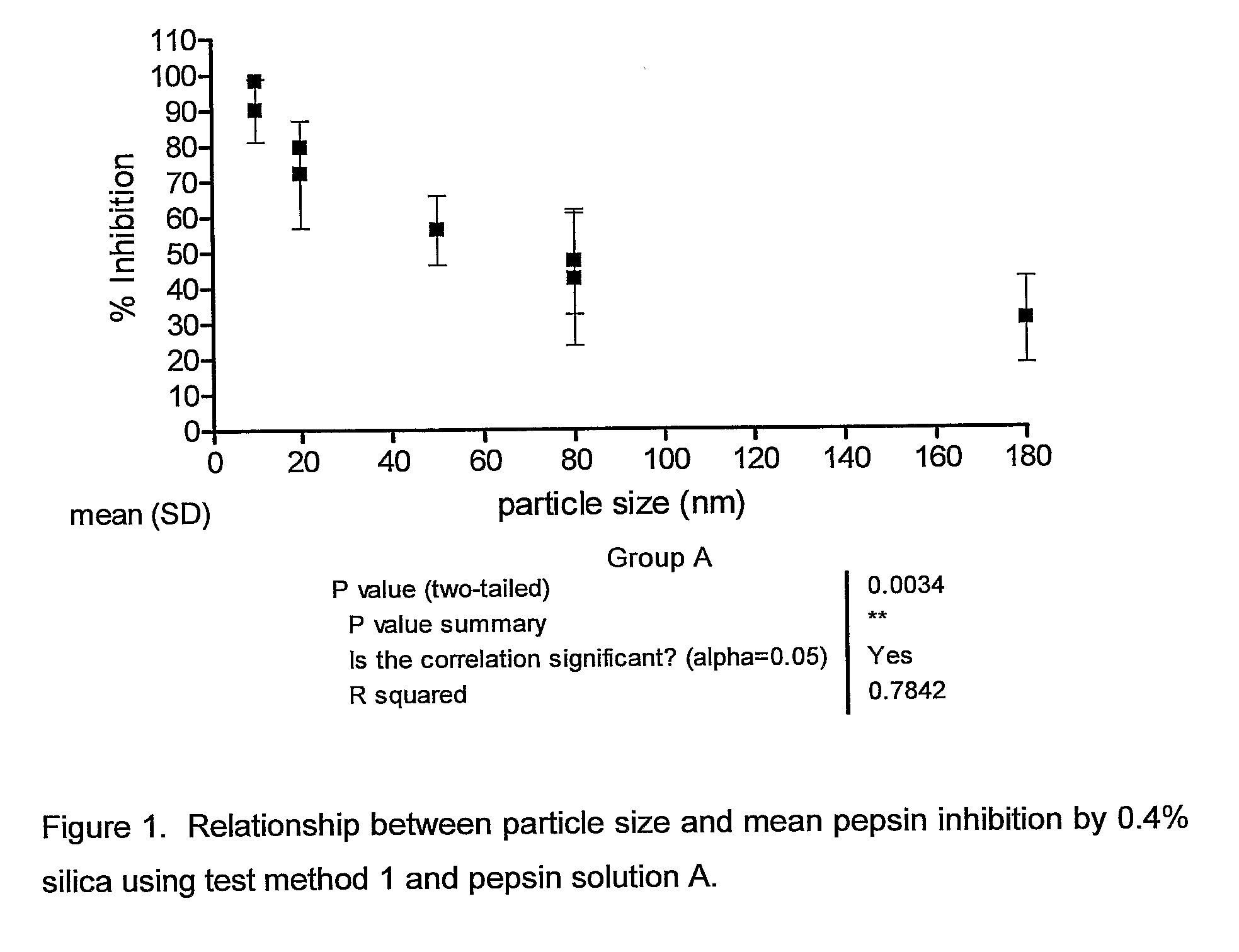Silicia for the inhinition of a protease
a protease inhibitor and silica technology, applied in the field of silica for the inhibition of a protease, can solve the problems of extensive tissue damage, tissue destruction and gastric injury, and achieve the effects of reducing the damage potential of reflux or luminal contents, effective disease therapy, and reducing the damage potential of luminal contents
- Summary
- Abstract
- Description
- Claims
- Application Information
AI Technical Summary
Benefits of technology
Problems solved by technology
Method used
Image
Examples
preparation of example 18 and 19
Colloidal Milled Silica
[0103]Equipment used for colloidal milling of Gasil HP270 to required particle size was the following:[0104]Eiger Torrance minimill 250[0105]182 ml Zirconium beads
[0106]The mill was assembled in accordance with the mill manufacturer's instructions using 182 ml of zirconium beads.
[0107]A Gasil HP270 slurry with a 12% w / v solid content was prepared (120 g in 100 ml demineralised water) and stirred for 10 minutes using an overhead paddle stirrer. The slurry was introduced to the mill and milled for 60 minutes at 4000 rpm. An aliquot was taken every 10 minutes for particle size distribution (PSD) analysis via Malvern Mastersizer to assess the progress of the milling.
[0108]Malvern Mastersizer method parameters were as follows:[0109]Pump, Stirrer and ultrasonics set at 50%[0110]2.5 minute dispersion time
example 22
Calcined Aerosil
[0111]10 g Aerosil placed in a 12 cm dish and then calcined at 300° C. in a furnace for 2 hours, before being removed to a dessicator to cool.
Pepsin Solutions
[0112]Pepsin (EC.3.4.23.1) was in the form of:
A) Porcine pepsin A (Sigma P-7012) with a specification of 2500-3500 units / mg protein. Pepsin was dissolved in 0.01M HCl (pH 2.2) to a concentration of 0-100 μg / ml.
B) Human gastric juice diluted in 0.01M HCl (to a concentration equivalent to 0-100 μg / ml of porcine pepsin).
C) Purified human pepsin 3 diluted in 0.01M HCl (to a concentration equivalent to 0-100 μg / ml of porcine pepsin).
D) Porcine pepsin A (Sigma P-7012) with a specification of 2500-3500 units / mg protein. Pepsin was dissolved in glycine / HCl buffer pH 2 to a concentration of 1 mg / ml.
E) Porcine pepsin A (Sigma P-7012) with a specification of 2500-3500 units / mg protein. Pepsin was dissolved in 0.01 M HCl to a concentration of 3 mg / ml
Methods
[0113]Test Method 1—Pepsin Inhibition by Silica with Collagen Substr...
PUM
 Login to View More
Login to View More Abstract
Description
Claims
Application Information
 Login to View More
Login to View More - R&D
- Intellectual Property
- Life Sciences
- Materials
- Tech Scout
- Unparalleled Data Quality
- Higher Quality Content
- 60% Fewer Hallucinations
Browse by: Latest US Patents, China's latest patents, Technical Efficacy Thesaurus, Application Domain, Technology Topic, Popular Technical Reports.
© 2025 PatSnap. All rights reserved.Legal|Privacy policy|Modern Slavery Act Transparency Statement|Sitemap|About US| Contact US: help@patsnap.com

